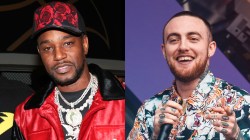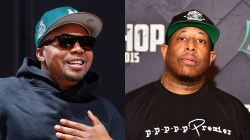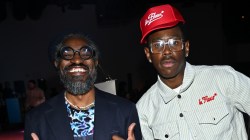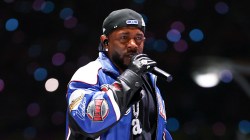The 90s were packed to the hilt with incredible works of music that were also incredibly commercially successful. Especially from ’95 onward, Hip Hop was a commodity selling millions of records a year. And there are quite a few artists, catapulted into the spotflight because of a hefty lead single or follow-up, that eventually found the platinum promise land either during the decade or over the ensuing years.
Others were not so lucky, and although they were superlative and of great importance to Hip Hop as a whole, they somehow were not well received enough by the album buying public to reach the one million mark. And this is our barometer. In a world where Will Smith’s Big Willie Style goes 9x platinum and Vanila Ice’s To The Extreme is also out collecting platinum checks, that these albums couldn’t find their way into the wallets of a million people is downright criminal. So, here, we present 10 classic albums from the 90s that, somehow, never hit one million albums sold territory.
People’s Instinctive Travels And The Paths Of Rhythm
Three classic recordings dropped in the inaugural year of the 1990’s and two of them went platinum. The first was Public Enemy’s Fear Of A Black Planet, which featured the varied aural landscape only an environment low on sample clearances could muster. The third was Ice Cubes AmeriKKKa’s Most Wanted, signifying the power of N.W.A. (and its fallout) and pillared by, well, the power of Cube’s vivid narrative over fantastic production. But right smack in the middle was the debut of quad-pronged Rap grouping A Tribe Called Quest. Q-Tip, Phife Dawg, Ali Shaheed-Muhammed and Jarobi burst out of the NY scene coming out of Queens, and made an album that most people didn’t know what to do with at the time, and although The Source gave the record 5 mics sales still managed to flounder. This one is an example of how crucial a first single is. The group dropped “Description Of A Fool” initially instead of far more successful (and just flat out better) follow-ups “Bonita Applebum” and “Can I Kick It?”. Because of that, the album floated around in commercial circles, going Gold several years later, but is and will always remain a Hip Hop staple for devotees and casual listeners of the genre alike.
De La Soul Is Dead
“Hello boys and girls…” the intro which sets the tone for the NY trio: Posdunuos, Dave and Maseo. Somewhere in between 1991’s west coast gun totin’ and “power to the people” tracks, De La Soul managed to squeeze their 2nd album in (fictitious radio station and all) named De La Soul Is Dead. The title mocks their original reception and “Daisy” approach to music, which took the back seat in a gangster prevalent Rap world. On their second album, De La became disillusioned with the current Hip Hop environment with (Vanilla Ice taking number one spots) and set up a metaphor in which kids found their album in the garbage. The album was truly of a “moment,” chronicling what was happening in the environment at the time in much the same way Spike Lee’s Do The Right Thingdid. They scoffed at being referred to as the “Hippies of Hip Hop”, and somehow created an album that spoke both the Native Tongues language all while putting forth their lament. Deeply personal and truly ironic, De La Soul Is Dead is a precursor to all of the hipster Rap that floated around the web in the aughts, and their view that Hip Hop would eventually go into a sugar coma lacking in what 1991 would have deemed “substance” has all but come true.
Bizarre Ride II The Pharcyde
One of Delicious Vinyl’s first groups to be signed in the 90s was The Pharcyde, who ultimately changed the face of what was thriving in the Golden State. South Central, Los Angeles spawned the likes of Imani, Slimkid3, Bootie Brown and Fatlip, who were clearly more so shaped by the sounds influencing the likes of De La Soul and A Tribe Called Quest (whom they later went on tour with). This was evident in Bizarre Ride II The Pharcyde; their first full length production. Perhaps the City of Angels wasn’t ready to hop on their bizarre ride of introspective lyricism, warped voices, and acid jazz production. There was no mention of the street life, instead it was all about having fun and having crazy adventures as described in “Oh Shit”and “Passin’ Me By”. Hip Hop enthusiasts today will always have J-Swift’s beats in their collection and we’ll never let them pass us by. Sadly the group would lose two of its members in the years following this Hip Hop classic: Fatlip in 1995 and Slimkid3 in 2000.
‘93 ‘til Infinity
September 28, 1993 was the date Souls of Mischief released their debut studio album, ‘93 ‘til Infinity. Their peers and competition at the time were heavy hitters The Wu-Tang Clan, A Tribe Called Quest (now on their third album), Snoop Dogg, KRS-One and De La Soul. The album is definitely a classic due to the iconic fat beats and jazzy sound, but it was its consistency that astounded. Most Hip Hop heads have the title track memorized for word, and it even charted, peaking at 72 on the Billboard 100. But what makes this album so special isn’t its title single (which is a staple of classic Hip Hop, golden age wizardry) but it’s relatively complex emotional take on their everyday lives. As far as slice of life albums go, 93 ‘til Infinityis one of Hip Hop’s most beloved and most underrated, and countless groups since have copied its topics and harmonies.
Resurrection
Still very influenced by the Empire State, the Rap game was learning to accept the likes of the South and the Midwest. Enter Common Sense. Resurrectionwas the Chi City native’s second album and it included the classic single and commercial hit “I Used To Love H.E.R.”. Common’s work with No I.D. didn’t seem to reach as many ears as expected, which is surprising because of both the seminal Hip Hop hit that was the aforementioned, and the overall intensity of I.D on the boards. It didn’t though, only landing 2000 copies the first week. But it was a watershed moment for the Chicago emcee (and the Hip Hop world by extension) as critics and Hip Hop heads alike lauded the record. And it solidified Common’s ability to capture an essence of the zeitgeist that would continue into his later work. Several even consider it Common’s best work and, therefore, a must for anyone’s collection. In 2000, mainstream would finally embrace the Chicago emcee when his first major label album Like Water For Chocolate dropped and peaked at number 16 on the Billboard Top 200.
The Infamous
This album put Mobb Deep on the map, but the sales paled in comparison to the previous month’s release of Tupac’s Me Against The World, which, despite a few outliers, was almost universally regarded by critics as ‘Pac’s best album but still just a slightly above average one. Robert Christgau (writing for The Village Voice) had this to say, “Tough-guy sentimentality is an old story in American culture, but self-pity this rank is usually reserved for teen romances and tales of brave avant-gardists callously rejected by the mass media.” There was no such sentimentality on Mobb Deep’s The Infamous. The gritty, dystopian lyrical content and menacing production provided a candid look into a cultural cache´ that many in the wider culture simply ignored. Both coasts would continue to delve into these stories, with New York’s version coming to define the spirit of the “golden era.” Of course, the duo brought the pessimists view to city life, taking a dispirited approach, but they also brought with them a classic from “the dungeons of Rap” to the doorsteps of middle class kids everywhere in America who were fascinated their city counterparts and had never heard anything quite this “dark.” The Infamous, went certified gold fairly quickly, but couldn’t go platinum spinning tales of pure chaos with all-time great songs like “Shook Ones pt. II”.
Ridin’ Dirty
1996 saw the release of ATLiens,the sophomore album by Atlanta supergroup OutKast, but two years before a shy Andre Benjamin (the beginning of what would become a legitimate stage fright showing) would state at the Source Awards, “The south got somethin’ to say.” In 1988 a group called Underground Kingz or U.G.K. released The Southern Way, and it was the South’s introduction to Bun B and Pimp C, two Port Arthur folks who grew up in the shadow of oil refineries and gravitated to what 8Ball & MJG called “country rap.” Now, they’d both collide, as Ridin’ Dirtywould come to solidify what we all know and love about Texas rap: candypaint gleaming in the light, lean, screwtapes, grillz and soul samples galore. The album never had any singles or videos, but reached certified gold status, and is their best selling album to date. Houston Hip Hop has expanded by leaps and bounds since, but it suffered from Hip Hop’s regional bias at the time, which is our shame because of this album’s greatness.
The War Report
The War Report was Capone-N-Noreaga’s debut album, and it was one of the most unapologetic, breathtaking views into the reality of life in LeFrak City – a sprawling Queens’ apartment complex comprised of twenty 16 story towers. The effect of their isolation was a deeply held dog-eat-dog view, and from that philosophical position is where they relayed their tales of grisly crime, street justice, and rules of existence. Unfortunately for C-N-N, the thematic portrait painted under the guidance of Tragedy Khadafi may have been too “street”, but the album still attained considerable success, crescendoing on the Billboard 200 chart at 21. The War Report was a showing from the Queens natives that garnered them commercial success even though most of the orchestrating was done by Noreaga on his own after Capone was sent to prison. Noreaga went on to a successful career as a mainstream artist, and the fans were left to wonder what levels of greatness could have been achieved had Capone not been hit with that trip up north.
Mos Def & Talib Kweli Are Black Star
Two of Hip Hop’s great philosophers teamed up with DJ Hitek, Shawn J. Period and a few others to give you one of New York’s pillars of edutainment. “Mos Def & Talib Kweli Are Black Star,” was a remarkable product, especially in 1998 amidst the swirling candycane fad that was the “shiny suit era.” There was not one wasted bar by each emcee, and both seemed to be both in competition with each other (constantly one-upping each other on tracks) and in harmony — folding their verses into the narrative of the other. These students of Marcus Garvey delivered a project of Native Tongues like conviction and honesty that existed outside of the time in which it was created. However, the mainstream was already long out the door, preferring the bling of Jay-Z’s Vol 2… Hard Knock Life or the maniacal storytelling and implicit violence and spirituality of DMX. Singles like “Definition” peaked on the Billboard 100 chart at 60, and the album itself peaked on the Billboard 200 at 53, but what we will remember most is how each verse catapulted these emcees into a conversation for greatness. Though their approach ran outside of mainstream interests at the time and received little radio play, this record will live on as one of Hip Hop’s all time greats.
Black on Both Sides
Speaking of the artist formally known as Mos Def moving on to a solo career, he followed up the Black Star collaboration with his Rawkus Records debut and first solo album “Black on Both Sides.” The critically acclaimed showing sparked talk of an entrance into a new era of Hip Hop, and the album only sold just over 500,000 copies, but it never reached the plumage of platinum, despite the selling frenzy the Hip Hop music industry was in at the time. Black on Both Sides gave us everything Def was beginning to become known for, an infectious rhyme scheme, afrocentric productions, and a spirituality woven into intricately laid bars that could at times take your breath away. “Ms. Fat Booty” is still one of the most dopalicious odes to a woman’s magnificence in Rap history, and the twist at the end still one of Hip Hop’s most treasured. Its not going plat’ aside, Black on Both Sides was an impressive way to end the 90s, and would influence both Hip Hop and R&B artists to present day.
RELATED: 10 Great Hip Hop Producers & Their Unlikeliest Collaborations [List] Paperham Lincoln is a product of Indiana with a slightly oxymoronic infusion of Hip Hop journalism, now interning in the editorial section at HipHopDX. Find Paper preaching all things raw and purveying truths of the new sort. Follow him on Twitter @PaperhamLincoln.
Karina Dominguez is an LA native who started writing for personal, artistic reasons at age 17, then evolved her writing style while becoming a contributor for an indigenous pop culture e-magazine. Her love for Hip Hop is thanks to Biggie’s Ready To Die album and she works with the community on various cultural or socially conscious projects. You can follow her on Twitter @_LArain.



![Method Man Admits He Didn't Like Drake's "Wu-Tang Forever": "I [Wasn't] Getting On That"](https://hiphopdx.com/wp-content/uploads/2025/12/method-man-drake-wu-tang-forever-remix.jpg?w=250)






MOBB DEEEP & SOULS OF MISCHIEF are the only surprises. SOM didn’t even go gold. I know they got gaffled by their record label cause tons of people I know were bumping that 93 TIL INFINITY til they couldn’t listen to it anymore. UGK went gold with no airplay/video play. A TRIBE CALLED QUEST 1st album was not that good. Their 2nd & 3rd albums put them into elite status cause they updated their flows & beats. DE LA SOUL was just what they were: a solid group that did about as good as they were gonna do. MOS DEF & TALIB were new on the scene and did good by going gold. COMMON was still finding his identity and had a strong fanbase but not good enough for platinum status at the time. This article sucks
Did you seriously just say that the first Tribe album wasn’t that good?
I mean that’s your opinion but you’re the first person I have read or heard say that.
The War Report is not, I REPEAT: NOT CLASSIC!
You smokin crack, War Report was a classic, you could play it from beginning to end with skippin a track, any real hip hop head will give War Report love as a classic. That shit would blow 90 percent of the albums made today out the frame.
Bro the War report was a classic. It wasn’t the Infamous kind of classic but it was a classic
i dont fuck with war report and i could kick your teeth in
dope ass list
The Infamous is the only surprise on this list because it is the best album on it. This goes to prove that NIGGAS don’t care about uplifting/ happy go lucky feel good rap music and only like gutter trash. Don’t get me wrong the gutter trash is good too but with moderation. I know black kids in prestigious universities that speak like a damn Migo. Must be too white to speak well
My top 5 favorite albums from this list:
Tribe
Infamous
De la
War Report
Black on Both Sides
Epitome of hip hop!
this is for you dumb fans that think that going platinum make you the best rapper/artist
MC Eiht – WE COME STRAPPED
Comptons Most WANTED – It’s a Compton Thang
add those to the list
Brand Nubian- One For All
Pete Rock and CL
EPMD
That’s wot these teens don’t understand. Record sales means “nothing”. Record sales is only relevent to the companies making money off it.Listeners only care if a albums dope or not.Record company suits and ties don’t care about dope hip hop.They only care about what corny “flavour of the month” ABC/123 weak ass rapper can make them the most money. Then they try to force feed weak music to people.So the weak minded teens hear it so much that they start to think “it must be dope”.I’ve seen people discussing the tactics that they use to “force” people into liking wack weak artists. Like getting wack records constant radio spins etc. Record sales don’t dictate the best album.The best albums are classics that stand the test of time and people talk about them for years .
There’s no such thing as “gutter thrash” hip hop.Hip hop is from the streets,the ghetto.its not meant to sound pretty.if u want music to uplift u maybe u need to listen to emotional singers.Hip hop is street news.music that tells the realities of the streets.its not a rappers job to uplift people. Maybe drob a few gems(knowledge) now and again.like some hardcore rappers do
I’m so tired of this ghetto news bullshit..stfu with that noise. you’re telling me that weak ass shit you hear today is ghetto news? or is it broke ghetto people peddling trash? I remember not to long ago everyone was drinking lean and getting stupid because of broke ghetto people influence in this country through rap. Hardcore rappers back in the day were more therapeutical with there lyrics and touched wide ranges but now its just drugs, sex, clubs, and terrible vernacular. so are you gonna keep using that excuse to justify gutter trash
Anonymous 2 you missed the whole entire point of Anonymous one post. I guess you from the suburbs. I disagree with Anonymous 1 on that note of its only street music. Suburban mothers fuckers could tell their suburb life stories too. But i agree with everything else you said. Rap music isn’t made to be pretty. Tho at times it could be very flashy.
Nah I understood bruh. its just a tired of excuse. I’m tryna tell most people are numb to it and don’t look at it that way anymore. Rap music is pop music. its poetry that poor blacks created and made popular cause it was edgy and different. Now its at its peak and it influences culture heavily in more negative aspects than good. It’s not hearing the news of the streets, its ghetto poor blacks perpetuating negativity through the communities and most importantly the youth
rap is now what rock was in the 90s
or jazz in the 80s
I co sign “uptownfirst” war report is a straight classic.I remember wen I was a lil kid and my friends older Bro must of done him a copy and he gave me a copy on cassette.I loved that shit.”T.O.N.Y” “iced out meddalions” etc bangers after bangers.I got that on my mp3 stash.That still sounds fresh now.Classic = Timeless.u could put that head 2 head with tons of new albums and they wouldn’t touch that album.They wouldn’t touch a lot of classic albums.u can tell the dope new rappers that grew up on 90’s hip hop.U can hear it in there music
No redman “muddy waters” wtf.That’s a straight classic.alongside war report.murda muzic?that’s a classic.I actually prefer it to infamous.The production sounds doper.infamous is a straight classic though.
Murda Music went like double platinum. And i wouldn’t be surpised if Muddy Waters is platinum by now too.
^^^ You have no idea what those albums are certified do you lol, even though you have google.
Murda Muzik is platinum and Muddy Waters is gold.
they forgot Mac Dre rapper gone bad and 3xkrazy stackin chips. try showin some love for the west coast some time hhdx those was classic gangsta rap albums, yea they wasn’t mainstream but this is supposed to be a hiphop site isn’t it? they west aint just snoop dogg and backpack rap.
luniz – operation stakola
If headline was “20” classic 90’s album……..then maybe a lot of other classics would of got mentioned.Did reasonable doubt and illmatic go platinum?what about those classic boot camp click joints?”nocturnal.”DA storm” “Da shining” etc
I’m 100% sure that Illmatic went platinum, it just took a little while.
Illmatic and Reasonable Doubt are both platinum. Why do you need to ask this?
Yeah I think ur right about illmatic bruh.I remember reading somewhere before that illmatic gradually went platinum but took awhile
Are you dumb? Just look it up. It went plat in 2001.
UGK Ridin’ Dirty CLASSIC CLASSIC.
The Sun Rises In The East.
but it sets in the west
Explains the death of the Genre
Classic album. One the greatest of all time. One of dj premiers best produced albums aswell
Thanks for mentioning this one
Dela, only good? Tribe’s debut wasn’t that good? To the wannabe critic down there, go listen to heavy metal. These fuckin’ hipsters need to shut the fuck up when it comes to our culture.
blah blah our culture our culture. you sound like a RACIST white man from the 1960s south. The music doesn’t belong to you as a race and people of all colors enjoy it and if they think they want to do it or critic it then they can because its not hard. Rap music has such a conservative ignorant attitude all the time, yall better get over it
Go try that reverse racism non-sense on something else, money. It is ‘our’ culture and some of us will not stand passively while some ass wipe Johnny-come-lately proceeds to tell us who, what, where, why, when as lame ass Rosenshitberg found out.
thanks Har. these anonymous newbies are often insufferable.
platinum don’t mean shit to me as a hiphop fan. it has no baring on whether I pick up an album or not. When an album goes platinum that just means that it was marketed well. Which usually means it gets played on the radio a million times a day and forced down peoples throats. no thank you!!!
uptil I saw the bank draft which was of $4239 , I didnt believe that my cousin was like they say realy bringing in money in there spare time from there labtop. . there aunt started doing this 4 less than 17 months and resantly paid the morgage on their condo and purchased themselves a Smart ForTwo . why not check here
==================
http://WWW.WORKS6.COM
==================
it doesn’t really matter but I’m pretty sure the first single on the first Tribe album was “I Left My Wallet In El Segundo”
I bought infamous, 93 til and bizarre ride back when those albums dropped and still have these in my collection today. Classic, timeless hip-hop. Never cared about the other joints on this list. One of the most underrated albums of all-time has got to be “blah blah blah” by Blahzay. A classic east coast album that I’m lucky enough to own. Peace.
Young Thug >
no surprises here
This article was dope. Dope because it hit some crazy albums that some of us never knew didn’t hit the charts even though we cherish them. But PLEASE… FUCKING PLEASE, don’t turn into some bum ass Buzzfeed type of site. If theres gon’ be list articles, make them like this and some “10 rappers whose names start with the letter Q” type of shit
Hip hop was popular but not as popular in the early 90’s as it was in the late 90’s. Also a lot of these albums were debuts without a big push from the radio or MTV. The first time I heard Ms.fat booty was at a rave party in the fall of 99 and that was around the same time Pharoh monch simon says was on a lugs commercial and being played at parties.
r.i.p. hiphop
your a ding dong licker
couldn’t say it any better
Soul Food by Goodie Mob would have topped my list.
Dope List! ALL killer albums!!!
Cant believe that first Mobb joint didnt go platinum. That was the shit!
Second Mobb joint you mean
Niggas will say im bugging but to me if Illmatic is the bible of rap that means the Infamous album is the Koran. Ain’t proud of it but im from the projects in NY and the pictures Prodigy painted on “The Infamous album,” reminded me of the same story I use to witness in my hood.
WAR REPORT AND INFAMOUS HIP HOP CLASSICS!
Got every one of these albums on vinyl. Good memories, the little i remember…
93 til Infinity – definite classic
where’s dah shinin’and enta stage?????????
All great albums.
I own them.
I just don’t think hip-hip in the 90’s had the same strength in numbers as crossover artists.
That’s my opinion.
Gold was good enough for a lot of record labels to support and sustain artists.
One of the only albums on that list that still sounds current if you were to play it today and that wouldn’t contain a lot of old slang and beat tempos and flows that would sound corny today, is Ridin Dirty.
You’re an idiot.
I still listen to black on both sides one of hip hops most underrated albums